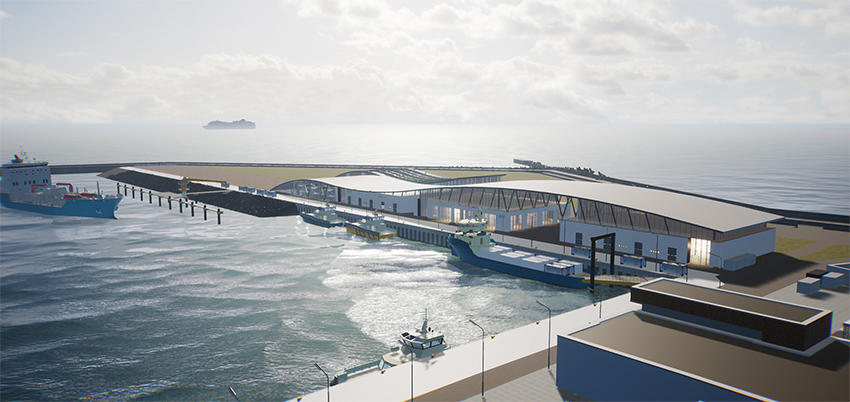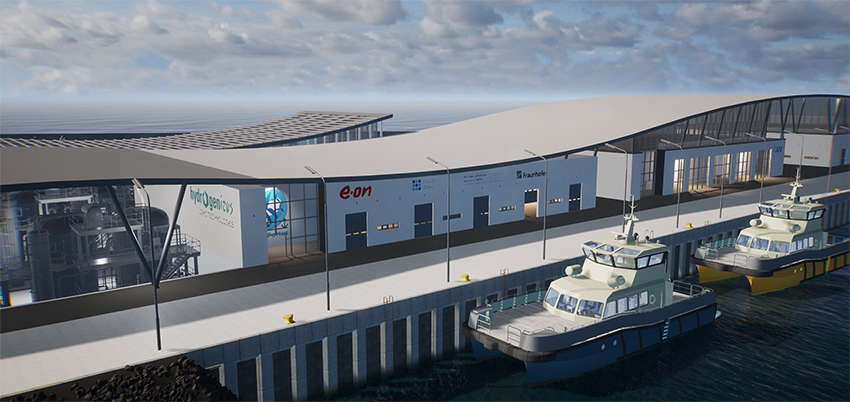First funding package secured for research and development along the hydrogen transport chain


The future starts now: With up to 12.48 million euros in funding from the Federal Ministry of Education and Research (BMBF), the research and development work in the TransHyDE Heligoland project is entering the active phase. Common goal of the project partners: The establishment of a hydrogen transport chain from the offshore area near Heligoland via the ports to the hydrogen consumers on the mainland. Technologies are being researched and developed for this purpose to store and transport green hydrogen in liquid organic hydrogen carriers (LOHCs). The project belongs to the BMBF's hydrogen lead project TransHyDE and is part of the broad-based AquaVentus initiative, in which all hydrogen activities around the Heligoland south port are bundled under the name AquaPortus.
Joint path to a climate-neutral future
"We are delighted about the endorsement and the boost that is being given to us as we embark on the hydrogen era with our project partners in the ports of Hamburg and Heligoland. AquaPortus is an important building block for our entire AquaVentus family so that we can bring green technologies of the future to market maturity on the way to climate neutrality," says Heligoland's mayor and AquaVentus chairman Jörg Singer.
"We are excited that we will be able to further test all the benefits of our LOHC technology in the TransHyDE Heligoland project. Together with the Heligoland utility companies, we are also enabling the island's heat supply to be converted from heating oil to carbon-neutral LOHC process heat on and for Heligoland. And by setting up a LOHC release plant in the Port of Hamburg, we will not only be able to ensure a flexible, safe, simple and efficient supply of green hydrogen in the surrounding area in the near future, but we are already creating the first building block for a large-volume import infrastructure in line with the German government's National Hydrogen Strategy," explains Rafael Schmidt, Head of Business Development at Hydrogenious LOHC Technologies.
Transporting hydrogen via the organic hydrogen carrier LOHC has many logistical advantages, emphasises Karin Debacher, TransHyDE project manager at Hamburger Hafen und Logistik AG (HHLA). "With the TransHyDE Heligoland project, HHLA intends to develop the requirement for a sustainable and economical LOHC transport chain. We also want to gain practical experience in transporting and dehydrogenating hydrogen using LOHC," says Debacher.
On the occasion of the TransHyDE project funding announcement, Thomas Birr, Chief Strategy & Innovation Officer for E.ON, points out the importance of green hydrogen especially for medium-sized companies: "E.ON offers the many small and medium-sized companies in Europe in particular solutions aimed at decarbonizing both their heating and cooling generation and their production processes. Forward-looking projects based on green hydrogen will play an increasingly important role here in the future."
All project partners, including the municipality of Heligoland, Versorgungsbetriebe Helgoland GmbH, E.ON, Hamburger Hafen und Logistik AG (HHLA), Hydrogenious LOHC Technologies, Tewis Projektmanagement GmbH as well as GASCADE Gastransport GmbH, the Fraunhofer Institute for Manufacturing Technology and Advanced Materials IFAM and the AquaVentus coordination office are now looking forward to working together on this innovative project.
Next steps in research and development
TransHyDE Heligoland focuses on the question of how the green hydrogen produced at sea can be stored and transported to consumers on the mainland. "That's why we're working together to lay the foundations for initial pilot and stand-alone solutions for LOHC use, which we will then implement on a demonstrator scale," explains project coordinator Christoph Tewis. Various application possibilities and scenarios are to be examined, compared and evaluated during the research and development phase. "Our goal is to develop a specific plan for the large-scale implementation of hydrogen conversion, storage and utilization both on Heligoland and on the mainland, as well as to investigate large-scale, trans-regional transport chains based on LOHC," Tewis continued. Furthermore, in addition to the work on Heligoland and the mainland, extensive scientific investigations are planned by Fraunhofer IFAM to store and transport hydrogen in the form of LOHC.
About AquaVentus
The project family around the AquaVentus initiative comprises numerous sub-projects along the value chain from the production of hydrogen in the North Sea to its transport to customers on the mainland. These coordinated consortia synchronize demand and production, thus enabling a rapid market ramp-up. The AquaVentus project family includes, for example: The development of offshore wind turbines with integrated hydrogen production (AquaPrimus), a large-scale offshore hydrogen park (AquaSector), a central offtake pipeline (AquaDuctus), port infrastructure and transport chains (AquaPortus), maritime hydrogen-based applications (AquaNavis) and a research platform (AquaCampus).
All information, including about our founding members, can be found at http://www.aquaventus.org
About the hydrogen lead projects
The hydrogen lead projects constitute the largest research initiative of the Federal Ministry of Education and Research (BMBF) on the subject of the energy transition to date. In the industry-led lead projects, industry and science are jointly developing solutions for the German hydrogen economy: Series production of large-scale electrolysers (H2Giga), production of hydrogen at sea (H2Mare), technologies for the transport of hydrogen (TransHyDE).
The lead project TransHyDE evaluates and tests hydrogen transport solutions. A hydrogen economy cannot function without a suitable transport infrastructure, which is why four transport technologies are to be further advanced in demonstration projects: (1) hydrogen transport in high-pressure containers, (2) liquid hydrogen transport, (3) hydrogen transport in existing and new gas pipelines, and (4) transport of hydrogen bonded in ammonia or the carrier medium LOHC.
More information is available in German on the BMBF website at
https://www.wasserstoff-leitprojekte.de/leitprojekte/transhyde
AquaVentus Förderverein (in Gründung)
c/o Gemeinde Helgoland
Lung Wai 28
D – 27498 Helgoland
Last modified:
 Fraunhofer Institute for Manufacturing Technology and Advanced Materials IFAM
Fraunhofer Institute for Manufacturing Technology and Advanced Materials IFAM